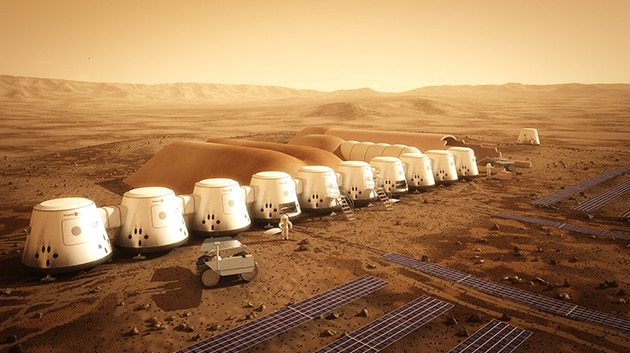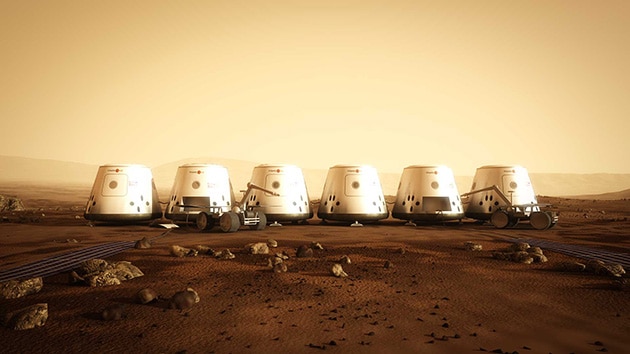
- Semiconductor Technology Now
Scientist Interview
Mission: Establishing a Human Settlement on Mars by 2023
April 22, 2013

A project to send humans to Mars by 2023 is now under way. But there is a caveat: it’s a one-way mission. The astronauts will be chosen from around the world in an open competition, and the project will be financed by selling the rights to televise the entire mission in real time, from crew training to Mars landing. The innovative business model, along with the mission plan that makes full use of existing technologies, was designed by a private Dutch venture. As the first media team from Japan to visit Mars One’s office, Telescope Magazine interviewed its rising young co-founder to learn all about this project.
Sourcing and integrating technologies from all over the world
 |
Telescope Magazine: As Mars One is planning a manned mission to Mars, we had assumed your headquarters was something like a rocket factory, but yours is just like any other office.
Bas Lansdorp: Building rockets in-house is not how we do things at Mars One. Rather, we plan the mission by combining existing technologies like pieces of a puzzle. Instead of designing the mission first and then sourcing necessary technologies, we started by taking stock of available technologies, and went on to design the mission by piecing the technologies together. The mechanical components for the mission are sourced from all over the world, including the U.S., Canada, Italy, the U.K., and Holland.
Telescope Magazine: The technologies that allow humans to fly to Mars and settle there must be very complex. Are you saying that those technologies are already available?
Bas Lansdorp: That’s right. They are either already well established or are close to becoming available. For example, our prospective rocket supplier SpaceX has already succeeded in launching unmanned rockets to the International Space Station (ISS) a few times. If there were humans inside, they most likely would have survived. The rocket that SpaceX uses today is the Falcon 9, which has one rocket core and a capsule attached on the top. The next version, the Falcon Heavy, needs two side boosters, but they are almost the same as the rocket core that they already have. And the second thing that we want to procure from SpaceX is the landing capsule, which looks a lot like the capsule they use today to land things from the ISS back to the Earth. This is 3.6 meters in diameter, and we want them to build one for us which is 5 meters in diameter. These are the only two technologies that are not fully established yet. All other technologies, including the life support systems, the Rover, the Mars suits and so on, are already available. Of course the specific components for our mission have to be built and engineered, but there’s nothing new to be invented for us.
 |
Telescope Magazine: So, you are going to outsource all those components and integrate them?
Bas Lansdorp: Well, we don’t exactly buy components; rather we buy services to launch a rocket to Mars and land it on Mars. So we don’t touch the rocket production process at all. When it comes to integration, there is a big difference between what NASA or the European Space Agency (ESA) does and what we are doing. NASA and ESA are political organizations, and they are obligated to procure components from a number of companies within the U.S. or the E.U. All these components ought to fit together, but they often don’t. Perhaps there are better suppliers outside their territories, but using them is not an option for NASA and ESA. Because Space One is more international, we can look for the best systems available throughout the world based on our expert consultants’ advice. That’s why we can procure principal components much cheaper and faster than either NASA or ESA.
Telescope Magazine: As your mission is about inhabiting Mars, you would also need the equipment for habitation.
Bas Lansdorp: Yes. We need such things as a landing capsule, inflatable living units, robotic systems that prepare the outpost before the humans arrive, and the Mars suits. Then there’s the transit habitat—the little space station in which the astronauts will travel from the Earth to Mars.
Telescope Magazine: Your mission on Mars is scheduled to start in 2023. How did you choose this timing?
Bas Lansdorp: Mars and the Earth rotate around the sun in such a way that the window for launching spacecraft to Mars comes only once in 26 months, and the window is open only for two or three months. First we need to land the Dragon capsule on Mars from space to demonstrate that the technology works. Then we need to do a Rover mission to determine the suitable spots for habitation. We already know the general area where the outpost will be, but we have to determine the exact spots that are flat and have enough water in the soil. Then in 2020, a lot of cargo arrives on Mars, including two living units, two life-support units, and a spare Rover—it’s such an important component that we need two of them in case one breaks down. And when all this is in place, we can send humans. We figured that we could do the demo mission in 2016, the Rover mission in 2018, the cargo mission in 2020, and the human crew departs in 2022, landing in 2023.
 |



















